Metal shrinking is a valuable technique used in various applications such as auto body repair, toolmaking, and fabrication. It involves altering the shape of metal by applying heat, force, and cooling processes. This method is especially beneficial for repairing dents, correcting distortions, and restoring the original shape of metal components. It undergoes thermal expansion and contraction by strategically heating and cooling the metal, allowing it to shrink and regain its desired form.
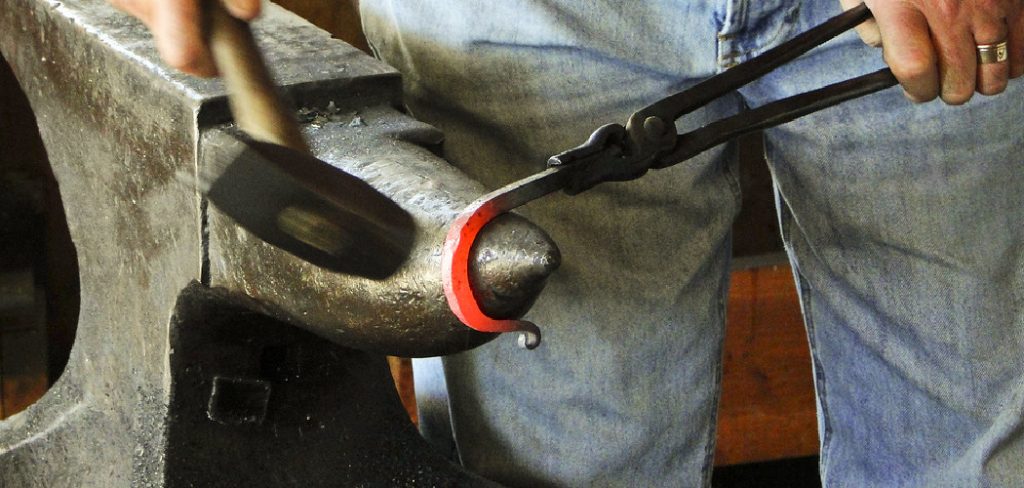
Metal shrinking is commonly employed in industries where precision and accuracy are paramount. This technique plays a crucial role, from repairing damaged vehicle panels to creating intricate metalwork. In this guide, we will explore the tools, techniques, and materials involved in the metal shrinking process, providing you with the knowledge and skills to effectively shrink metal and achieve desired results. So, let’s dive in and learn how to shrink metal!
Tools and Materials Needed
To successfully shrink the metal, you will need a range of tools and materials at your disposal. Here are the key items required for the metal shrinking process:
Tools
- Heat sources: torch, heat gun, or welding equipment. These provide the necessary heat to expand the metal for the shrinking process.
- Hammer and dolly for shaping. These tools help manipulate the metal and achieve the desired form.
- Shrinking disc or shrinking hammer (optional for precision). These specialized tools help shrink specific areas with greater accuracy and control.
Materials
- The metal piece to be shrunk: this can include sheet metal, aluminum, steel, or other metals that require shrinking.
- Cooling agents like water or compressed air. These help rapidly cool the heated metal, initiating the shrinking process.
- Safety gear: gloves, goggles, and heat-resistant clothing. These are essential to protect yourself from potential hazards associated with high heat and metal manipulation.
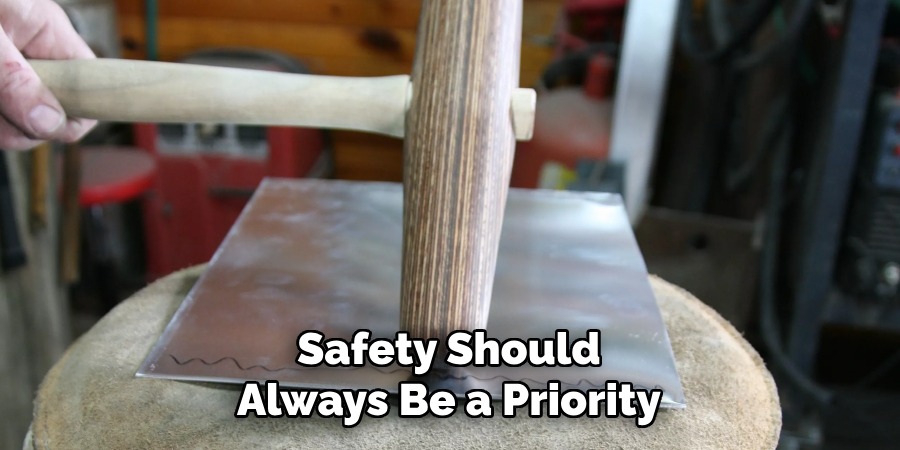
Having the right tools and materials on hand ensures that you are well-equipped to effectively shrink metal and achieve the desired results. Safety should always be a priority, so make sure to use appropriate safety gear and follow proper procedures throughout the process.
Understanding the Metal Shrinking Process
Metal shrinking is a technique for reshaping and repairing metal surfaces by applying heat and inducing controlled contraction. To effectively shrink metal, it is crucial to understand how metal behaves under heat and the common methods used in the process.
How Metal Behaves Under Heat
When metal is heated, it undergoes thermal expansion, causing it to expand in size. Conversely, when the heat is removed, the metal contracts or shrinks back to its original size. This behavior is due to a metal’s atomic structure, where heat energy causes the atoms to vibrate and move further apart, resulting in expansion. The cooling process reduces the energy, causing the atoms to come closer together, leading to contraction.
Common Methods of Metal Shrinking
The two primary methods used for metal shrinking are heat and mechanical.
Heat Shrinking with a Torch or Disc
This method involves applying heat to the targeted area using a torch or heat disc. The heat source is moved circularly around the metal surface, gradually heating the area to the desired temperature. Once the metal reaches the appropriate temperature, it is rapidly cooled using water, air, or a damp cloth. The rapid cooling causes the metal to contract and shrink, effectively reshaping and repairing the surface.
Mechanical Shrinking Using Force and Shaping Tools
Mechanical shrinking involves using force and specialized shaping tools to reshape the metal. This technique is often used with heat shrinking or as an alternative method. The metal is manipulated and reshaped by applying pressure strategically to achieve the desired form. This method requires skill and precision to ensure proper alignment and avoid excessive force that could lead to further damage.
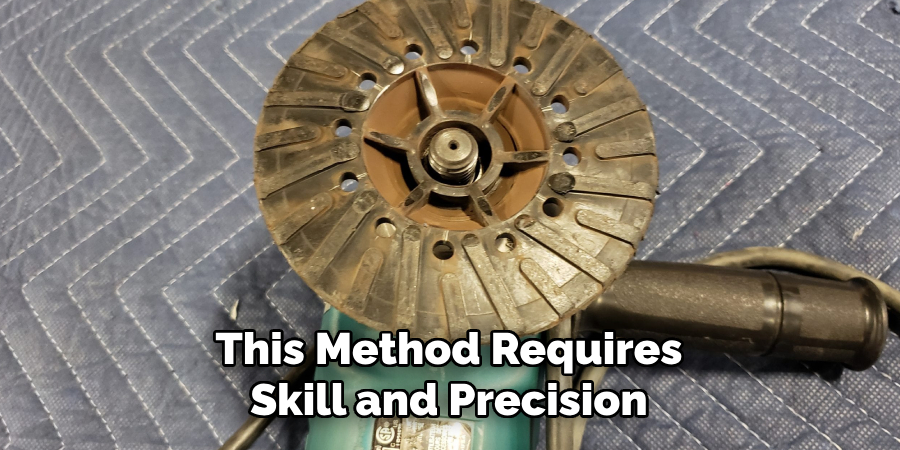
Understanding the principles behind thermal expansion and contraction and the different methods of metal shrinking equips you with the knowledge to effectively apply these techniques and achieve the desired results in metal shaping and repair.
How to Shrink Metal: Heat Shrinking Technique
Heat shrinking is a widely used method in metal shaping and repair, involving the controlled application of heat to achieve the desired form. This technique leverages the principles of thermal expansion and contraction to effectively reshape metal.
Preparing the Metal Surface
Before applying heat, preparing the metal surface for the shrinking process is essential. This involves cleaning the area to remove any dirt, oil, or debris that could interfere with the heat application. Additionally, marking the specific section to be shrunk helps ensure precision and targeted results.
Applying Heat
To initiate the shrinking process, heat is applied to the targeted area using a torch or a heat gun. Care must be taken to apply heat evenly and in a controlled manner. Proper temperature control is crucial to prevent overheating and damaging the metal. Observing color changes, such as a dull red hue for steel, can visually indicate the temperature.
Cooling and Shrinking
After the metal has been heated sufficiently, it is rapidly cooled to induce contraction and shrinkage. This can be achieved by using water, air, or a damp cloth to cool the heated area quickly. The rapid cooling causes the metal to contract, effectively reshaping it according to the desired form. For larger or more complex areas, the heating and cooling process may need to be repeated multiple times to achieve the desired result.
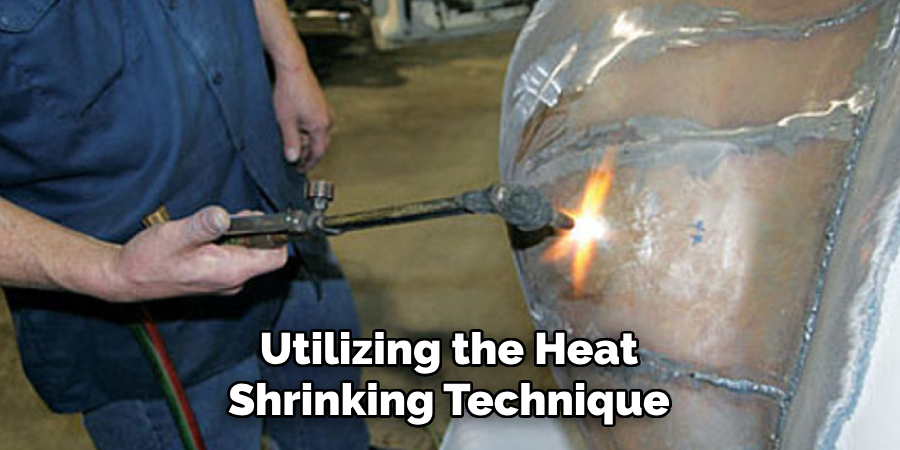
Utilizing the heat shrinking technique requires precision and careful control of temperature and cooling to avoid excessive distortion or damage to the metal. With practice and expertise, this method can effectively achieve precise shaping and repair in metalwork.
How to Shrink Metal: Mechanical Shrinking Technique
Mechanical shrinking is another method employed in metalwork to reshape and repair metal surfaces. This technique involves using specialized tools and mechanical force to compress and shrink the metal, effectively altering its shape. Several approaches to mechanical shrinking include using a shrinking hammer, working with a shrinking dolly, and cold shrinking.
Using a Shrinking Hammer
One common tool used in the mechanical shrinking process is a shrinking hammer. This hammer is specifically designed with a rounded face to strike the metal in controlled patterns. The force applied compresses and shrinks the area by striking the metal surface, allowing for precise shaping and contouring. It is crucial to exert consistent force while using a shrinking hammer to avoid uneven results and ensure uniform reshaping.
Working with a Shrinking Dolly
Another technique in mechanical shrinking involves using a shrinking dolly. This tool supports the back side of the metal while hammering. By placing the dolly behind the area being worked on and striking the metal against it, the force is evenly distributed, minimizing the risk of deformation. Working with a shrinking dolly allows for more controlled shaping and contouring, resulting in a more refined finish.
Cold Shrinking
Cold shrinking can be employed as a mechanical shrinking technique in certain situations. Unlike heat shrinking, cold shrinking does not rely on temperature changes but instead applies mechanical force to make small-scale adjustments. This method is particularly useful for fine-tuning and making minor corrections in metalwork. While cold shrinking can be effective for small adjustments, it has its limitations compared to heat shrinking, such as its inability to reshape larger or more complex areas.
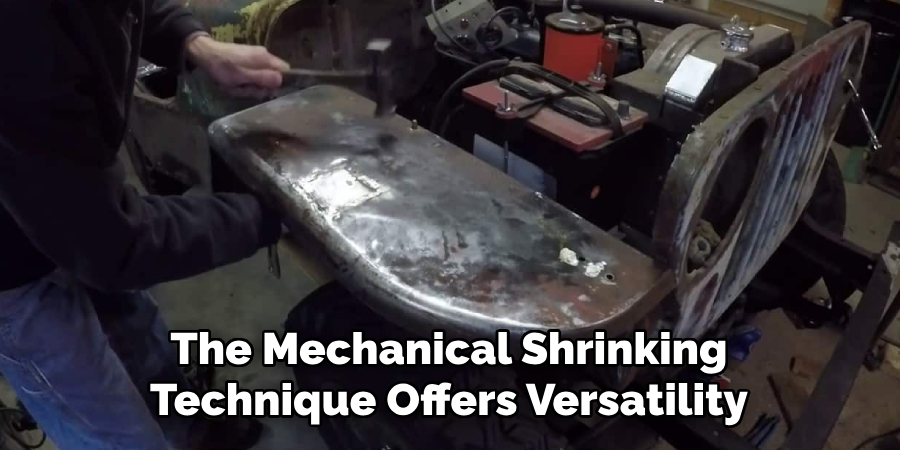
Overall, the mechanical shrinking technique offers versatility and precision in reshaping and repairing metal surfaces. Whether using a shrinking hammer, working with a shrinking dolly, or utilizing cold shrinking methods, careful application and skillful execution are essential for achieving the desired results. Each approach has its own benefits and considerations, and the choice of technique depends on the specific requirements of the metalwork project.
Safety Considerations
When working with metal shrinking techniques, it is essential to prioritize safety to avoid accidents and injuries. Here are some key safety considerations to keep in mind:
Protective Gear
Wearing appropriate protective gear is crucial to shield yourself from potential hazards.
- Importance of heat-resistant gloves, goggles, and appropriate clothing: Heat-resistant gloves protect your hands from burns, while goggles safeguard your eyes from sparks and metal fragments. Wearing appropriate clothing, such as long sleeves and pants, provides an additional layer of protection.
Ensuring Proper Ventilation
Proper ventilation is essential to prevent inhaling harmful fumes that may be generated during the metal shrinking process. Ensure that you work in a well-ventilated area or use exhaust fans to remove fumes and maintain good air quality.
Handling Tools and Materials Safely
It is important to handle tools and materials with care to prevent accidents or damage.
- Using heat sources with caution: When working with heat sources like torches, heat guns, or welding equipment, exercise caution to avoid burns or fire hazards. Follow proper operating procedures and keep flammable materials away from heat sources.
- Storing tools securely after use: After completing your work, store tools safely and organized to prevent injuries and maintain longevity.
By prioritizing safety measures and being mindful of potential risks, you can create a secure working environment and ensure a successful and incident-free metal shrinking process.
Common Applications of Metal Shrinking
Metal shrinking has applications in various industries, from automotive repairs to metal fabrication projects. Here are two common areas where metal shrinking techniques are frequently utilized:
Automotive Repairs
Metal shrinking is vital in restoring vehicles to their original condition in the automotive industry. It is often used to correct dents and restore body panels, improving the overall alignment and surface smoothness. By precisely shrinking the affected areas, technicians can eliminate unsightly dents and ensure a seamless finish. Metal shrinking also helps improve the vehicle’s structural integrity, eliminating stress points and preserving its longevity.
Metal Fabrication
In the field of metal fabrication, shrinking techniques are employed to adjust metal shapes in both artistic and industrial projects. Whether it’s custom metal sculptures or specific industrial components, metal shrinking allows for precise manipulation of metal to achieve the desired shape and dimensions. Additionally, by effectively shrinking metal, fabricators can enhance the structural integrity of their creations, ensuring that stress points are eliminated and the final product meets the required specifications.
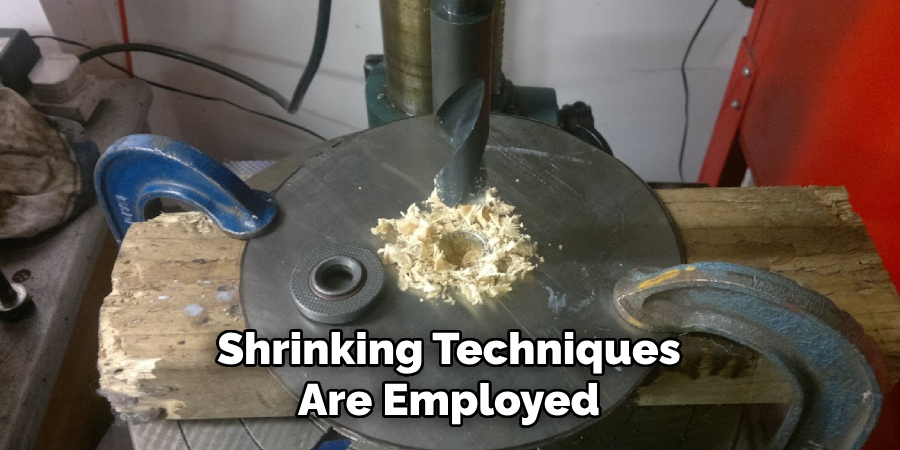
By incorporating metal shrinking techniques, professionals in automotive repairs and metal fabrication can achieve exceptional results, restoring surfaces and shapes with precision while maintaining the integrity of the metal.
Conclusion
In conclusion, mastering the art of metal shrinking is essential for professionals in automotive repairs and metal fabrication. Experts can achieve exceptional results in restoring surfaces and manipulating metal shapes precisely by following the appropriate steps and techniques, such as heating and cooling methods, using specialized tools, and applying tension.
Choosing the right method for each specific project is crucial, considering factors like the type of metal, desired outcome, and structural integrity requirements. Practice and refinement of skills are key to achieving optimal results. So, embrace the challenge, experiment with different approaches, and become proficient in the art of how to shrink metal for outstanding craftsmanship and lasting durability.
Edmund Sumlin is a skilled author for Metal Fixes, bringing 6 years of expertise in crafting a wide range of metal fixtures. With a strong background in metalwork, Edmund’s knowledge spans various types of fixtures, from decorative pieces to functional hardware, blending precision with creativity. His passion for metalworking and design has made him a trusted resource in the industry.
Professional Focus:
- Expert in Metal Fixtures : Edmund aesthetic specializes in creating durable and innovative metal fixtures, offering both appeal and functionality. His work reflects a deep understanding of metalworking techniques and materials.
- Sustainability Advocate : He is dedicated to using sustainable practices, ensuring that every fixture is crafted with eco-friendly methods while maintaining high-quality standards.
In his writing for Metal Fixes, Edmund provides valuable insights into the latest trends, techniques, and practical advice for those passionate about metal fixtures, whether they are professionals or DIY enthusiasts. His focus on combining artistry with engineering helps others discover the true potential of metal in design.


